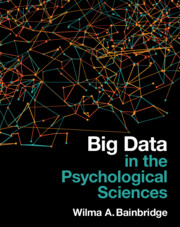Refine search
Actions for selected content:
58 results

Big Data in the Psychological Sciences
-
- Published online:
- 23 October 2025
- Print publication:
- 23 October 2025
-
- Textbook
- Export citation
7 - Big Human Intelligence
-
- Book:
- Big Data in the Psychological Sciences
- Published online:
- 23 October 2025
- Print publication:
- 23 October 2025, pp 117-132
-
- Chapter
- Export citation
8 - Effective Human–AI Collaborative Intelligence
-
-
- Book:
- Human-AI Interaction and Collaboration
- Published online:
- 19 September 2025
- Print publication:
- 09 October 2025, pp 175-212
-
- Chapter
- Export citation
‘Well, if you want to play with fire, make sure the flames are tamed’: investigating the integration of idiom literal completions across literal and creative contexts
-
- Journal:
- Language and Cognition / Volume 17 / 2025
- Published online by Cambridge University Press:
- 10 July 2025, e55
-
- Article
-
- You have access
- Open access
- HTML
- Export citation
13 - Will Innovation Change Innovation?
-
- Book:
- Innovation Management
- Published online:
- 06 June 2025
- Print publication:
- 10 July 2025, pp 192-209
-
- Chapter
- Export citation
Crowdsourcing the assessment of wine quality: Vivino ratings, professional critics, and the weather
-
- Journal:
- Journal of Wine Economics / Volume 19 / Issue 3 / August 2024
- Published online by Cambridge University Press:
- 02 January 2025, pp. 285-304
-
- Article
-
- You have access
- Open access
- HTML
- Export citation
Development and validation of a nonverbal consensus-based semantic memory paradigm in patients with epilepsy
-
- Journal:
- Journal of the International Neuropsychological Society / Volume 30 / Issue 7 / August 2024
- Published online by Cambridge University Press:
- 15 April 2024, pp. 671-679
-
- Article
-
- You have access
- Open access
- HTML
- Export citation
Conclusion
-
- Book:
- Before the Word Was Queer
- Published online:
- 14 March 2024
- Print publication:
- 21 March 2024, pp 176-197
-
- Chapter
- Export citation
Evaluating large-language-model chatbots to engage communities in large-scale design projects
-
- Article
-
- You have access
- Open access
- HTML
- Export citation
Decentralized crowdsourcing medical data sharing platform to obtain chronological rare data
-
- Journal:
- Data & Policy / Volume 6 / 2024
- Published online by Cambridge University Press:
- 12 February 2024, e9
-
- Article
-
- You have access
- Open access
- HTML
- Export citation
What makes an awfully good oxymoron?
-
- Journal:
- Language and Cognition / Volume 16 / Issue 1 / March 2024
- Published online by Cambridge University Press:
- 18 January 2024, pp. 242-262
-
- Article
-
- You have access
- Open access
- HTML
- Export citation
11 - Technology
-
- Book:
- Frontline Crisis Response
- Published online:
- 28 September 2023
- Print publication:
- 12 October 2023, pp 171-189
-
- Chapter
- Export citation
L’apport des données participatives pour l’étude linguistique des français du monde : le cas de l’opposition /a∼ɑ/
- Part of
-
- Journal:
- Journal of French Language Studies / Volume 34 / Issue 2 / July 2024
- Published online by Cambridge University Press:
- 24 August 2023, pp. 249-272
-
- Article
-
- You have access
- Open access
- HTML
- Export citation
Virtuous opinion change in structured groups
-
- Journal:
- Judgment and Decision Making / Volume 18 / 2023
- Published online by Cambridge University Press:
- 03 August 2023, e25
-
- Article
-
- You have access
- Open access
- HTML
- Export citation
CROWDSOURCING ENGINEERING DESIGN PROBLEMS: LEARNING FROM EXPERIENCES
-
- Journal:
- Proceedings of the Design Society / Volume 3 / July 2023
- Published online by Cambridge University Press:
- 19 June 2023, pp. 1107-1116
-
- Article
-
- You have access
- Open access
- Export citation
The collective intelligence of random small crowds: A partial replication of Kosinski et al. (2012)
-
- Journal:
- Judgment and Decision Making / Volume 14 / Issue 1 / January 2019
- Published online by Cambridge University Press:
- 01 January 2023, pp. 91-98
-
- Article
-
- You have access
- Open access
- HTML
- Export citation
29 - Reflections on Urban Cultural Heritage, Public Health, and Public Participation
- from Part VI - Cultural Heritage Protection and Cross-Disciplinary Opportunities for Advancing Disaster Law and Policy
-
-
- Book:
- The Cambridge Handbook of Disaster Law and Policy
- Published online:
- 27 October 2022
- Print publication:
- 29 September 2022, pp 468-476
-
- Chapter
- Export citation
Facilitating Real-Time, Multidirectional Learning for Clinicians in a Low-Evidence Pandemic Response
-
- Journal:
- Disaster Medicine and Public Health Preparedness / Volume 17 / 2023
- Published online by Cambridge University Press:
- 21 September 2022, e246
-
- Article
-
- You have access
- Open access
- HTML
- Export citation
The Portable Antiquities of the Netherlands: A Review
- Part of
-
- Journal:
- Advances in Archaeological Practice / Volume 10 / Issue 3 / August 2022
- Published online by Cambridge University Press:
- 25 August 2022, pp. 347-353
-
- Article
-
- You have access
- HTML
- Export citation
14 - Crowdsourcing Cyber Peace and Cybersecurity
- from Part IV - Reflections and Research Notes
-
-
- Book:
- Cyber Peace
- Published online:
- 21 April 2022
- Print publication:
- 05 May 2022, pp 230-235
-
- Chapter
-
- You have access
- Open access
- HTML
- Export citation
